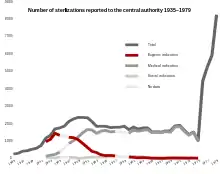Compulsory sterilisation in Sweden
Compulsory sterilisation in Sweden were sterilisations which were carried out in Sweden, without a valid consent of the subject, during the years 1906–1975 on eugenic, medical and social grounds. Between 1972 and 2012, sterilisation was also a condition for gender reassignment surgery.

Legal grounds
The general rule between 1941 and 1976 was that sterilisation was illegal, but there were three grounds on which sterilisation could be permitted:[5]
- Medical, if a pregnancy could seriously put a woman suffering from chronic illness or permanently weakened constitution at risk of life and health.
- Eugenic, which allowed sterilising people considered insane or with severe illness or with a physical disability.
- Social indication allowed sterilisation of people considered unsuitable to foster a child due to mental illness, being feebleminded or having an antisocial lifestyle.
It was never legal to physically restrain a person.[6]
From 1944, the number of eugenic sterilisations under the 1941 legal provisions gradually decreased.
Statistics
The number of eugenic sterilisations peaked in the 1940s; from 1946, the number of sterilisations under the 1941 legal provisions gradually decreased.[7]
In 1997, on behalf of the Swedish government, the ethnologists Mikael Eivergård and Lars-Eric Jönsson made an attempt at estimating what percentage of sterilisations were coerced. They found that a quarter of the applications were made under circumstances similar to coercion such as a condition for release from an institution and that another 9 percent were signed under pressure. In half of the cases they found no sign of coercion or pressure, but signs of the applicants' own initiative. Tydén uses these percentages to make an estimate of the number of operations under coercion. He found that 15,000 were made as a condition for release and that another 5500 to 6000 were made under other kinds of pressure, whereas 30,000 were voluntary and on the applicants' own initiative.[8] From the 2000s, the Swedish state paid out damages to victims who filed for compensation.[9]
Sterilisation during sex change
Until 2012, sterilisation was mandatory before sex change.[10] This last mandatory sterilisation has been criticised by several political parties in Sweden and since 2011 the Parliament of Sweden was expected to change the law but ran into opposition from the Christian Democrat party. After efforts to overturn the law failed in parliament, the Stockholm Administrative Court of Appeal overturned the law on 19 December 2012, declaring it unconstitutional[11][12] after the law was challenged by an unidentified plaintiff.
See also
References
- Tydén, Mattias (2002). Från politik till praktik: de svenska steriliseringslagarna 1935-1975. Stockholm studies in history, 0491-0842 ; 63 (in Swedish) (2., utvidgade uppl. ed.). Stockholm: Almqvist & Wiksell International. ISBN 91-22-01958-8.
- Allmän hälso- och sjukvård [Elektronisk resurs] (in Swedish). Stockholm. 1913–1982.
-
Nationalencyklopedin. "Den svenska steriliseringspolitiken - Uppslagsverk - NE.se". Retrieved 2018-02-27.
Ett viktigt motiv för att inte släppa steriliseringen fri var att den då skulle kunna användas för privat barnbegränsning.
- 1997 års steriliseringsutredning (2000), Steriliseringsfrågan i Sverige 1935-1975 [Elektronisk resurs] : historisk belysning, kartläggning, intervjuer : slutbetänkande, Statens offentliga utredningar, 0375-250X ; 2000:20 (in Swedish), Stockholm: Fritzes offentliga publikationer, p. 156
- SOU 1974:25 Fri sterilisering, "The current Sterilization Law (1941: 282) is restrictive. License is required for sterilization and permission is granted only if certain restricted conditions of an eugenic, social or medical nature are fulfilled."
- Tydén, Mattias (2002). Från politik till praktik. p. 586. ISBN 9789122019589. Retrieved 2018-08-09.
The Swedish laws never allowed the use of physical force. Furthermore the great majority of sterilisations were made following a personal application. Nevertheless many sterilisations took place in a context of compulsion or coercion, as it would be defined today.
- Kurbegovic, L. (n.d.). Sweden. Retrieved February 28, 2020, from https://eugenicsarchive.ca/discover/world/51c2742697b8940a54000009
- Tydén, Mattias (2002). Från politik till praktik : de svenska steriliseringslagarna 1935-1975. Stockholm studies in history, 0491-0842 ; 63. Stockholm: Almqvist & Wiksell International. pp. 69–70. ISBN 978-91-22-01958-9.
- Riksdagsförvaltningen (1999-07-01), Lag (1999:332) om ersättning till steriliserade i vissa fall Svensk författningssamling 1999:1999:332 t.o.m. SFS 2017:46 - Riksdagen, retrieved 2018-03-02
- Sweden keeps sex-change sterilisation law, The Local, January 12, 2012
- Nelson, Rebecca. "Transgender People in Sweden No Longer Face Forced Sterilisation". Time. ISSN 0040-781X. Retrieved 2016-09-01.
- "Good News For Sweden's Transgender Residents". The Huffington Post. 2013-01-14. Retrieved 2016-09-01.
- "Upphävande av kravet på sterilisering för ändrad könstillhörighet (Socialutskottets bet 2012/13:SoU24)" (in Swedish). Sveriges Riksdag. 22 May 2013. Retrieved 24 October 2020.